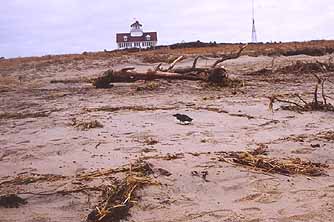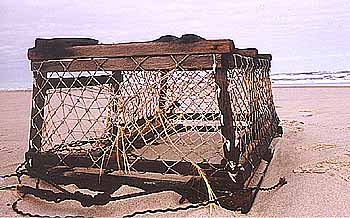| Over-hyped
storm: 'Fears and unappreciated mercies' |
BY DON WILDING
Sunday, March
11, 2001
Residents of states
along the eastern seaboard are all having a good chuckle at the weatherman
after last week's predicted "storm of the century" turned
out to be only the "hype of the century," but the spirits
of the Nauset region of Eastham may have shed a tear or two after the
nor'easter pounded the outer beach of Cape Cod without mercy.
Had the storm taken on "Blizzard of '78" proportions, as many
feared it would, what's left of Nauset Spit would be only a memory right
now. The fragment of beach where author Henry Beston built his famous
"Outermost House" is still there, but this historic barrier
beach took one more big step toward extinction last week when a 12-foot
storm surge made its mark here.
| As
was the case in '78, the ocean broke through the dunes in several
spots and flattened the beach, leaving it more than ready to be
consumed by the surf in the weeks and months ahead. Only 36 hours
after the storm had pulled away from the coast and headed out into
the open Atlantic, it was clear that this weather event had taken
a big bite out of this barrier beach, which is annually regarded
as one of |

Trees
and grass cover Coast Guard Beach. Note the small unidentified sea
bird in the middle of the picture. (Photo by Don Wilding)
|
the finest of its
kind in the world.
It was clear that the surf had risen to just a few feet below the area
overlooking the beach, where plaques dedicated to Beston and the old
Lifesaving Service stand. Large tree trunks and stumps, telephone poles,
lobster pots and other surprises covered the beach areas where the surf
had reached its high point.

The
mystery bird strikes a pose for the camera. (Photo by Don Wilding)
|
Scattered
among some of these treasures were several species of sea fowl.
Some were injured and had to be taken to local bird sanctuaries
to be nursed back to health. Some appeared to have blown off course
-- in fact, one bird, which looked like a cross between a pigeon
and a penguin, was nestled in among the debris on the beach in front
of the Coast Guard |
station. Days later,
bird experts on the Cape were still debating about what kind of bird
it actually is.
While the beach in front of the station was littered with debris, a
walk further down the beach showed less and less of anything. A stroll
through the dunes revealed a dead seal, stairs to a house (which bore
some resemblance to the steps of Beston's Fo'castle, which was washed
out to sea from this very beach in '78) and flattened dune grass, which
indicated that the ocean was indeed here only hours earlier. In between
some of these dunes were flattened out areas; sand paved by the surf
with bits of grass strewn about. Elements of black sediment were peppered
here and there for a natural artistic effect.
While
the mainland had been pounded with as much as three feet of snow
in some places, Eastham received only about two inches -- and that
was melting away in the 40-degree temperature of the day. Off in
the distance, on the hills of Eastham, were patches of snow, but
none was to be found on this desolate stretch of coast.
|

The
last 400 yards of Nauset Spit, south to the inlet -- only a sliver
remains. (Photo by Don Wilding) |
Reaching the end
of some of the larger dunes on the spit, I came to an area that used
to be roped off so that the nests of piping plovers could thrive. What
I saw resembled Cape Cod Bay at low tide -- the only wildlife thriving
here on a regular basis from now on would be marine creatures who make
their homes below the surface of the sand. The beach had closed in from
the east, while Nauset Marsh went through a massive expansion process
from the west.
From there to the inlet, a distance of about 400 yards or so, it was
nothing but flat sand. I debated about walking the final few hundred
yards, but came to the conclusion that I should. It might not be here
the next time I decide to hike this beach.

FURNITURE
FROM THE SEA -- Would look nice in the living room, but too heavy
to move.
(Photo by Don Wilding)
|
While
trees and other debris were all over the entrance to Coast Guard
Beach, nothing except for a large lobster pot was on this flat stretch
of sand. The lobster pot would make for a nice coffee table, I thought,
but getting it back to my car would be another matter. After coming
to the conclusion that I wouldn't be able to lift it, the only function
that this castoff |
from the ocean
would perform is to be a place to sit and rest for a few minutes.
Further down toward the inlet, one common centerpiece was no longer
in sight -- a large tree with many branches which had been bleached
by the sea. This once proud growth had been consumed by the ocean years
before, only to be deposited near the inlet's opening. Now, it was obvious
it had either been deposited elsewhere, or was completely buried in
the sand.
I felt a bit of irony as I observed what appeared to be a coot swimming
on the surface of the outgoing current of the inlet. The bird was no
doubt looking for lunch in this fast flow of water, but was facing the
west as the current carried him out toward the incoming breakers. Years
earlier, Beston's legendary house was carried out into the Atlantic
in much the same fashion. As the bird was pulled out a good 100 yards
in less than a minute, I could only imagine how terrified I would be
in such a situation. I eventually lost track of him, even with my binoculars.
He probably went diving for a fish, as these birds often do, but I also
couldn't help but worry that he might be in the same condition -- injured
-- as so many other members of his kind were on this day.
"As I write of I think of my beloved birds of the great beach,
and of their beauty and their zest of living," Beston wrote in
the concluding paragraphs of "The Outermost House." "And
if there are fears, know also that Nature has its unexpected and unappreciated
mercies."
More
photos of the storm's impact
Home

|




